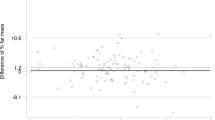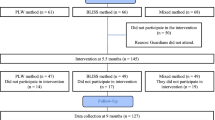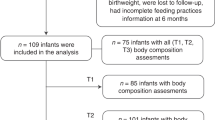Abstract
Objective: To investigate the extent to which breast milk is replaced by intake of other liquids or foods, and to estimate energy intake of infants defined as exclusively (EBF), predominantly (PBF) and partially breast-fed (PartBF).
Design: Cross-sectional.
Setting: Community-based study in urban Pelotas, Southern Brazil.
Subjects: A total of 70 infants aged 4 months recruited at birth.
Main outcome measures: Breast milk intake measured using a ‘dose-to-the-mother’ deuterium-oxide turnover method; feeding pattern and macronutrient intake assessed using a frequency questionnaire.
Results: Adjusted mean breast milk intakes were not different between EBF and PBF (EBF, 806 g/day vs PBF, 778 g/day, P=0.59). The difference between EBF and PartBF was significant (PartBF, 603 g/day, P=0.004). Mean intakes of water from supplements were 10 g/day (EBF), 134 g/day (PBF) and 395 g/day (PartBF). Compared to EBF these differences were significant (EBF vs PBF, P=0.005; EBF vs PartBF, P<0.001).
The energy intake of infants receiving cow or formula milk (BF+CM/FM) in addition to breast milk tended to be 20% higher than the energy intake of EBF infants (EBF, 347 kJ/kg/day vs BF+CM/FM, 418 kJ/kg/day, P=0.11).
Conclusions: There was no evidence that breast milk was replaced by water, tea or juice in PBF compared to EBF infants. The energy intake in BF+CM/FM infants tended to be 20% above the latest recommendations (1996) for breast-fed and 9% above those for formula-fed infants. If high intakes are maintained, this may result in obesity later in life.
Sponsorship: International Atomic Energy Agency through RC 10981/R1.
This is a preview of subscription content, access via your institution
Access options
Subscribe to this journal
Receive 12 print issues and online access
$259.00 per year
only $21.58 per issue
Buy this article
- Purchase on Springer Link
- Instant access to full article PDF
Prices may be subject to local taxes which are calculated during checkout


Similar content being viewed by others
References
Albernaz E, Victora CG, Haisma H, Wright A & Coward WA (2003): Impact of lactation counselling on breastmilk intake measured through isotopic methods: a randomized trial. J. Nutr. 133, 205–210.
Butte NF (1996): Energy requirements of infants. Eur. J. Clin. Nutr. 50, S24–S36.
Butte NF, Jensen CL, Moon JK, Glaze DG & Frost JDJ (1992): Sleep organization and energy expenditure of breast-fed and formula-fed infants. Pediatr. Res. 32, 514–519.
Butte NF, Wong WW, Ferlic L, O'Brian Smith E, Klein PD & Garza C (1990): Energy expenditure and deposition of breast-fed and formula-fed infants during early infancy. Pediatr. Res. 28, 631–640.
Butte NF, Wong WW, Patterson BW, Garza C & Klein PD (1988): Human-milk intake measured by administration of deuterium oxide to the mother: a comparison with the test-weighing technique. Am. J. Clin. Nutr. 47, 815–821.
Coward WA, Cole TJ, Sawyer MB & Prentice AM (1982): Breast-milk intake measurement in mixed-fed infants by administration of deuterium oxide to their mothers. Hum. Nutr. Clin. Nutr. 36, 141–148.
Davies PSW, Ewing G, Coward WA & Lucas A (1990): Energy metabolism in breast-fed and formula-fed infants. In Breast-feeding, Nutrition, Infection and Growth in Developed and Emerging Countries. ed. SA Atkinson, LA Hanson & RK Chandra, 521 pp. St John's Newfoundland: Arts Biomedical.
De Bruin NC, Degenhart HJ, Gal S, Westerterp KR, Stijnen T & Visser HK (1998): Energy utilization and growth in breast-fed and formula-fed infants measured prospectively during the first year of life. Am. J. Clin. Nutr. 67, 885–896.
De Onis M & Blössner M (2000): Prevalence and trends of overweight among preschool children in developing countries. Am. J. Clin. Nutr. 72, 1032–1039.
De Onis M, Victora CG, Garza C, Frongillo E & Cole T (2001): A new international growth reference for young children. In Perspectives in Human Growth, Development and Maturation, ed. P Dasgupta & R Hauspie. Dordrecht, The Netherlands: Kluwer Academic Publishers.
Dewey KG, Peerson JM, Brown KH, Krebs NF, Michaelsen KF, Persson LA, Salmenpera L, Whitehead RG & Yeung DL (1995): Growth of breast-fed infants deviates from current reference data: a pooled analysis of US, Canadian, and European data sets. World Health Organization working group on infant growth. Pediatrics 96, 495–503.
Drewett RF & Amatayakul K (1999): Energy intake, appetite and body mass in infancy. Early Hum. Dev. 56, 75–82.
Food and Nutrition Board (FNB) IOM (2002): Dietary Reference Intakes for Energy, Carbohydrates, Fiber, Fat, Protein and Amino Acids (Macronutrients). Washington, D.C: National Academies Press.
Hamill PVV, Drizd TA, Johnson CL, Reed RB & Roche AF (1977): NCHS Growth Curves for Children, Birth–18 Years, United States. Vital and Health Stat, National Center for Health Statistics, Series 11, No. 165, U.S. Government Printing Office, Washington, DC.
Heinig MJ, Nommsen LA, Peerson JM, Lonnerdal B & Dewey KG (1993): Intake and growth of breast-fed and formula-fed infants in relation to the timing of introduction of complementary foods: the darling study. Acta Paediatr. 82, 999–1006.
Hoffman DJ, Sawaya AL, Coward WA, Wright A, Martins PA, de Nascimento C, Tucker KL & Roberts SB (2000): Energy expenditure of stunted and nonstunted boys and girls living in the shantytowns of São Paulo, Brazil. Am. J. Clin. Nutr. 72, 1025–1031.
Holland B, Welch AA, Unwin ID, Buss DH, Paul AA & Southgate DAT (1991): The Composition of Foods, 5th Edition. Cambridge, UK: McChance and Widdowson.
IDECG (1996): Energy and protein requirements. Proceedings of an IDECG workshop. London, United Kingdom, 31 October–4 November 1994. Eur. J. Clin. Nutr. 50, S1–S197.
Infante C, Hurtado J, Salazar G, Pollastri A, Aguirre E & Vio F (1991): The dose-to-mother method to measure milk intake in infants by deuterium dilution: a validation study. Eur. J. Clin. Nutr. 45, 121–129.
Instituto Brasileiro de Geografia e Estatistica (1981): Estudo nacional da despesa familiar — ENDEF — tabelas de composição de alimentos, Rio de Janeiro.
International Atomic Energy Agency (1990): The doubly labelled water method for measuring energy expenditure. Technical recommendations for use in humans. A consensus report by the IDECG working group. NAHRES-4, Vienna, Austria, AM Prentice, 1990.
Kuczmarski RJ, Ogden CL, Guo SS, Grummer-Strawn LM, Flegal KM, Mei Z, Wei R, Curtin LR, Roche AF & Johnson CL (2002): 2000 CDC growth charts for the United States: methods and development. National Center for Health Statistics. Vital Health Stat 11, 1–190.
Labbok M & Krasovec K (1990): Toward consistency in breastfeeding definitions. Stud. Family Plann. 21, 226–230.
Lucas A, Ewing G, Roberts SB & Coward WA (1987): Measurement of milk intake by deuterium dilution. Arch. Dis. Child. 62, 796–800.
Mondini L & Monteiro CA (1997): The stage of nutrition transition in different Brazilian regions. Arch. Latinoam. Nutr. 47, 17–21.
Orr-Ewing AK, Heywood PF & Coward WA (1986): Longitudinal measurements of breast milk output by a 2H2O tracer technique in rural Papua New Guinean women. Hum. Nutr. Clin. Nutr. 40, 451–467.
Parizkova J & Rolland-Cachera MF (1997): High proteins early in life as a predisposition for later obesity and further health risks. Nutrition 13, 818–819.
Roberts SB & Lucas A (1985): Measurement of urinary constituents and output using disposable napkins. Arch. Dis. Child. 60, 1021–1024.
Rothman KJ & Greenland S (1998): Modern Epidemiology, 2nd Edition. Philadelphia, USA: Lippincott Williams & Wilkins.
Sachdev HP, Krishna J, Puri RK, Satyanarayana L & Kumar S (1991): Water supplementation in exclusively breast-fed infants during summer in the tropics. Lancet 337, 929–933.
Salazar G, Vio F, Garcia C, Aguirre E & Coward WA (2000): Energy requirements in Chilean infants. Arch. Dis. Child. Fetal Neonatal Ed. 83, F120–F123.
Victora CG, Morris S, Barros FC, Horta BL, Weiderpass E & Tomasi E (1998): Breast-feeding and growth in Brazilian infants. Am. J. Clin. Nutr. 67, 452–458.
Vio F, Salazar G & Infante C (1991): Smoking during pregnancy and lactation and its effects on breast-milk volume. Am. J. Clin. Nutr. 54, 1011–1016.
Wells JC & Davies PS (1995): Correction for environmental water influx in measurement of milk volume intake by deuterium turnover in infants. Early Hum. Dev. 41, 177–182.
WHO (1985): Energy and protein requirements . Report of a joint FAO/WHO/UNU expert consultation. Technical Report Series 724.
WHO (1994): Working group on infant growth. An evaluation of infant growth. WHO/NUT/94.8.
WHO (1998a): Complementary feeding of young children in developing countries: a review of current scientific knowledge. WHO/NUT/98.1.
WHO (1998b): Working group on the growth reference protocol. A growth curve for the 21st century: The WHO multicentre growth reference study. Protocol.
WHO (2001a): Global strategy for infant and young child feeding: the optimal duration of exclusive breast-feeding. Fifty-Fourth World Health Assembly. Document A54/INF.DOC./4, Geneva.
WHO (2001b): Infant and young child nutrition. Fifty-Fourth World Health Assembly. Resolution WHA54.2, Geneva.
WHO (2002): Working group on the growth reference protocol, WHO task force on methods for the natural regulation of fertility. Growth of healthy infants and the timing, type, and frequency of complementary foods. Am. J. Clin. Nutr. 76, 620–627.
Acknowledgements
We thank the women who participated in the study, and acknowledge contributions of Mara Santos, Verina Silva, Mirian Franz for sample collection; Ana Beatriz Palmeira and Ana Lucia Isquierdo for anthropometric measurements; Rita Silveira for quality control; Wilian Trinidade for data management, and Angélica Rodrigues for secretarial help. We thank Professor Roel Vonk (Groningen University) for stimulating discussions during the process of revision.
Author information
Authors and Affiliations
Corresponding author
Rights and permissions
About this article
Cite this article
Haisma, H., Coward, W., Albernaz, E. et al. Breast milk and energy intake in exclusively, predominantly, and partially breast-fed infants. Eur J Clin Nutr 57, 1633–1642 (2003). https://doi.org/10.1038/sj.ejcn.1601735
Received:
Revised:
Accepted:
Published:
Issue Date:
DOI: https://doi.org/10.1038/sj.ejcn.1601735
Keywords
This article is cited by
-
Concordance of the Deuterium Dose to Mother Method and 24-Hour Recall to Measure Exclusive Breastfeeding at 6 Weeks Postnatally in Rural/Urban Setting in Jamaica
Maternal and Child Health Journal (2022)
-
Human Milk output among mothers previously treated for severe acute malnutrition in childhood in Democratic Republic of Congo
BMC Nutrition (2021)
-
Early infant feeding effect on growth and body composition during the first 6 years and neurodevelopment at age 72 months
Pediatric Research (2021)
-
Development of a nonlinear hierarchical model to describe the disposition of deuterium in mother–infant pairs to assess exclusive breastfeeding practice
Journal of Pharmacokinetics and Pharmacodynamics (2019)
-
Cross-sectional assessment of infants’ exposure to toxic metals through breast milk in a prospective cohort study of mining communities in Ghana
BMC Public Health (2017)



